
 Fortunately (and much to Françoise's surprise), the route to the museum was well sign-posted, and a good thing, too! We actually found it on the first try.
Fortunately (and much to Françoise's surprise), the route to the museum was well sign-posted, and a good thing, too! We actually found it on the first try. Saturday, 2 July 2016, Touring with Françoise!
Written 4 July 2016
Saturday after breakfast, we walked over to collect Françoise at her hotel, and the three of us walked to Central Parking to pick up the car. Françoise said she knew pretty much now to get there, if we could figure out how to get out of the city headed in the right direction. I had therefore Google-mapped the route from Central Parking to our destination, then zoomed in and closely studied the initial stages. The map clearly showed us turning right out of the garage, then turning right again to drive one block the wrong way on a prominently marked (prominently marked right there on the Google map) one-way street before turning left to reach a rotary that would put us on the highway. Say what?
David announced that no way was he going to take Google's word on a thing like that; find another route. So I mapped out a rather more complicated alternative but pointed out that we would be walking that very stretch of one-way street on our way to get Françoise, so we should at least take a look.
To our surprise, at the crucial point, a skinny little traffic island (basically a piece of curb), with a "keep-right" arrow at each end, divided the one-way street into two narrow lanes for one block, then allowed it to flow back together, one-way once more. Before our eyes, cars and even large trucks were following Google's recommended route, so in the end, so did we.
The plan was to visit the new archeological museum at Eleftherna, which was only inaugurated last month and is largely undiscovered by tourists. We decided to drive west along the northern coast as far as Stavromenos, and then to turn inland (south) toward the museum and its cluster of archeological sites. We therefore set out, armed with a variety of semiadequate maps, but soon concluded that we'd missed a turn, as we were clearly not following the coast. We at first thought we were simply on the old road, which runs west farther inland, but when we finally came to a town that we could find on the map, we realized that we'd been headed mostly south the whole time. Ranges of mountains dictate the arrangement of roads in that area, and the best way to recover was clearly to drive all the way back to the outskirts of Heraklion to pick up the original route, the E75. (Except for the E, i.e., "European," level routes and a couple of N, i.e., "National" routes, the roads on Crete are not numbered.) Anywhere else, something numbered E75 would be a controlled-axis freeway. In Crete, it's a good two-lane road with wide shoulders paralleled by smaller access roads reached by infrequent turns. In that sense, it's "controlled access," but the side roads meet the highway at simple stop signs and are often unpaved.
We noticed early in the drive that the car in front of us persisted in driving with his right-side tires well over the line onto the paved shoulder. Françoise explained that he was, in this way, inviting us to pass him. So for the rest of the trip, we accepted such invitations and issued our own when faster cars pulled up behind us.
Reading signs was challenging, first because some were only in Greek letters (although most were in both Greek and Roman), second because the Roman spellings on the signs didn't always match those on the maps or on other signs (it depended on who did the transliteration and when and what language he spoke; e.g., &grbeta; sometimes became "b" and sometimes "v"), and third because taggers had spray-painted graffiti all over most of the signs, obscuring all the characters. (Françoise assured us that, although paint was popular in the north, bullet holes were more common in the south. Is gun ownership legal in Crete? No. Does everybody in Crete have guns? Of course; how else can you celebrate at weddings?)
At any rate, once we found the E75, it was smooth sailing until it came time to find our turn. We missed it the first time but made a U-turn at the next (yes, a simple U-turn back onto the main road, made by pulling off at a stop sign and waiting for a couple of cars to go by) and found it.

 Fortunately (and much to Françoise's surprise), the route to the museum was well sign-posted, and a good thing, too! We actually found it on the first try.
Fortunately (and much to Françoise's surprise), the route to the museum was well sign-posted, and a good thing, too! We actually found it on the first try.
Here are two views of the brand-new modern building, perched high on the slopes of Mount Ida. It theoretically overlooks the sea (which is miles to the north), but some trees were in the way from our vantage point.
Unfortunately, photography is forbidden throughout the museum. It included the usual preponderance of pots, jars, and other clay containers but also many striking pieces of ancient art. The site has been occupied since the Neolithic and shows layers and layers of cultural innovations and influences. The museum itself is small, just three rooms, but a map inside shows the layout of the many digs around it, over a couple of square miles. All those sites are closed to tourism just now, but some will be reopened soon.
Strangely, the museum includes no snack bar and no gift shop! We didn't have the place to ourselves, but it was by no means crowded, and most of the people there were Greek.
The labeling and explanatory panels were excellent, but I would make two suggestions (maybe I should write to them directly): First, it should include a time line somewhere, perhaps painted on a wall. For those of us unfamiliar with the ancient history of the area, the continuing use of the names of periods was very confusing. Even though dates were given, once you've read six panels, you've forgotten the dates from the first two. Did the Minoan come before or after the Phoenician? What were their relative lengths? When did the Romans show up? Second, they should paint a line on the floor below that great map indicating which way is north; north was indicated on the map, but I lost my sense of direction in all the hairpin turns up to the site, and when I looked out the window, the shadows were exactly under the trees. When I asked two docents, they pointed in opposite directions, so when I looked out windows, I couldn't tell which area of the map I had a view of.
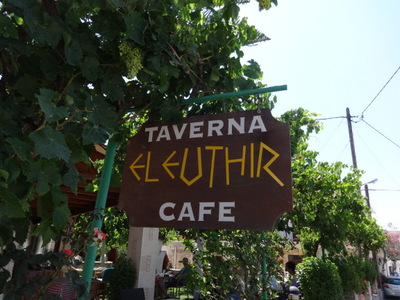
 Once we'd looked at everything on display, and our feet were beginning to complain, we headed back down the mountain scouting for lunch. We passed up a couple of places but finally came to the one whose sign is at the left. It was the first that didn't have a big tent sign out front advertising ice cream novelties. (Later, I spotted such a sign folded up and stashed behind its olive press, but at least it wasn't the first thing you saw.
Once we'd looked at everything on display, and our feet were beginning to complain, we headed back down the mountain scouting for lunch. We passed up a couple of places but finally came to the one whose sign is at the left. It was the first that didn't have a big tent sign out front advertising ice cream novelties. (Later, I spotted such a sign folded up and stashed behind its olive press, but at least it wasn't the first thing you saw.
It turned out to be a wonderful choice. We were a little early for lunch (12:40 p.m. is early for lunch in Crete), but the proprietor offered to call his mom, who did the cooking, to come over early to make our lunch. The photo at the right shows the lovely courtyard, several steps above the road, where we sat. It was well shaded by mulberry trees, their lower trunks whitewashed.

 The wall around the courtyard was topped by a grape arbor loaded with half-ripe grapes and puntuated by six or eight of these large urns. This one formed a beautiful backdrop for the dangling grape clusters.
The wall around the courtyard was topped by a grape arbor loaded with half-ripe grapes and puntuated by six or eight of these large urns. This one formed a beautiful backdrop for the dangling grape clusters.
David got this shot of Françoise and me. Behind us, you can see our rental car, parked on the street below. Françoise wears only broad-brimmed sun hats with an opening at the top. She likes to put her long silver hair in a pony tail and pull it out through the top of the hat.
In the course of our lunch there, we heard and saw many birds: Eurasian collared doves perched in the trees above us, house sparrows foraged under the tables, swallows (two species, maybe?) swooped around far overhead. I could hear, but not see, a canary (probably one of the streaky yellowish gray ones, not the bright yellow domestic sort) and a finch of some kind (probably the very common chaffinch).

 We waited a little while, but once Mama arrived, the food was great! We ordered two starters to share, both shown here at the left: fried eggplant and fried zucchini. Strangely, the wide, thin, half circles are the zucchini, and the fat round disks are the eggplant. The eggplant's skin was a little chewy, but otherwise, both were excellent, crispy on the outside and moist and tasty on the inside.
We waited a little while, but once Mama arrived, the food was great! We ordered two starters to share, both shown here at the left: fried eggplant and fried zucchini. Strangely, the wide, thin, half circles are the zucchini, and the fat round disks are the eggplant. The eggplant's skin was a little chewy, but otherwise, both were excellent, crispy on the outside and moist and tasty on the inside.
Françoise ordered the special of the day, fresh green beans cooked with potatoes in a tomato sauce. She expected string beans, but it turned out to be young green fava beans. The mixture was delicious anyway!
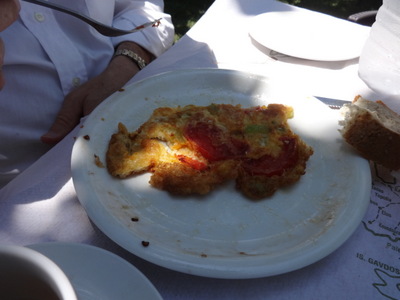
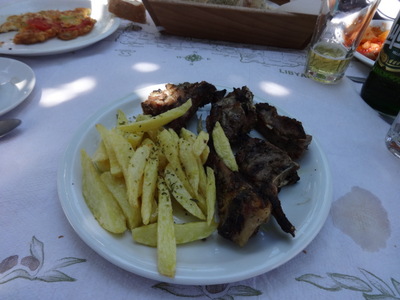 David ordered an omelet with tomatoes and peppers. It came out looking like a pizza, open-faced and crispy around the edges. The peppers were very pale green, but he said they tasted just like ordinary good bell peppers. With it, he had a cup of hot Cretan tea, which is an herbal mixture that tasted strongly of thyme and rosemary; excellent.
David ordered an omelet with tomatoes and peppers. It came out looking like a pizza, open-faced and crispy around the edges. The peppers were very pale green, but he said they tasted just like ordinary good bell peppers. With it, he had a cup of hot Cretan tea, which is an herbal mixture that tasted strongly of thyme and rosemary; excellent.
I, in my opinion, had the winner. I ordered the grilled lamb chops, which came with fries (lightly crisped but tasting more of actual potato than most French fries). The chops were (as Françoise had warned me was likely) all different shapes and sizes, but boy were they good! They were coated with salt and herbs and grilled over charcoal until crispy on the outside and slightly pink inside. I ate every single bit and gnawed those little bones bare. Best lamb chops I've ever had! Françoise pointed out that the lamb probably grew up on the surrounding hills eating the same things the tea was made of.
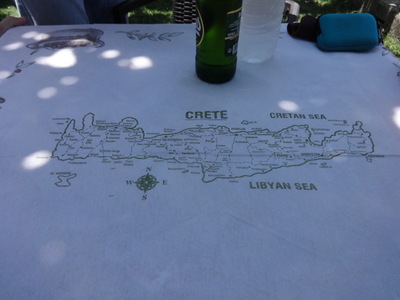
 Here are a couple of shots of the paper "tablecloth" we were served on. The center was decorated with this map of Crete and the corners with sprays of olive branches.
Here are a couple of shots of the paper "tablecloth" we were served on. The center was decorated with this map of Crete and the corners with sprays of olive branches.
Not much to show for the afternoon. We drove back, overshooting the city and taking the car directly back to the airport, where we turned it in with some relief—no more fighting the one-ways and hunting for parking. From there, we took a taxi back to town and retired to our respective hotels to rest up for dinner.
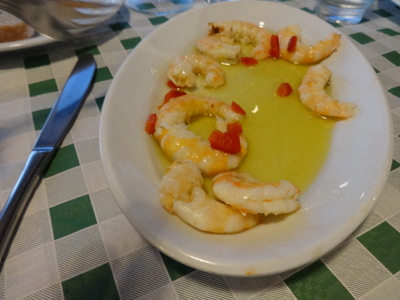
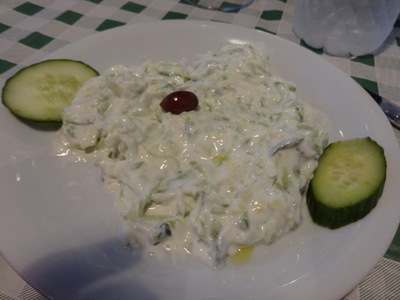 At dinner time, we collected Françoise from her hotel and walked down to the waterfront in search of seafood. David was in charge of driving and Françoise of cultural enrichment. Food was my department, so I'd done a little research and chosen Kastella (or maybe Kastello; opinions differ), which came highly recommended by colleagues here for the meetings.
At dinner time, we collected Françoise from her hotel and walked down to the waterfront in search of seafood. David was in charge of driving and Françoise of cultural enrichment. Food was my department, so I'd done a little research and chosen Kastella (or maybe Kastello; opinions differ), which came highly recommended by colleagues here for the meetings.
It's located in a row of similar establishments right where the mole (the one connected to the old stone fort) reaches the shore. Each restaurant has an outdoor terrace right on the water, but a busy highway runs between the terraces and the restaurants proper. Cleverly, they use electronic tablets that communicate orders directly to the kitchens, so only the food runners have to dodge through traffic, balancing trays.
David's starter was prawns marinated in olive oil and lemon. I ordered tsatsiki, a salad of shredded cucumber, garlic, and yogurt.

 Françoise was delighted to find urchin salad on the menu. As you can see in the left-hand photo, it looked more like urchin soup—slivers of roe floating in a clear liquid. The roe was very mild-flavored, not at all tinged with iodine. Françoise squeezed a little lemon over it and devoured the whole thing, declaring it perfect.
Françoise was delighted to find urchin salad on the menu. As you can see in the left-hand photo, it looked more like urchin soup—slivers of roe floating in a clear liquid. The roe was very mild-flavored, not at all tinged with iodine. Françoise squeezed a little lemon over it and devoured the whole thing, declaring it perfect.
Our main-course order was heavily influenced by the waiter, who brought to the table and showed us a platter displaying whole specimens of the freshest species of the evening, in the bright-eyed, mild-odored raw state: European sea bass, daurade (Sparus aurata), and a third species I didn't catch the name of, which he said was not on the printed menu. All three of us ordered the grilled European sea bass. As you can see in the photo at the right, I ate some of mine before I remembered to photograph it. All the grilled fishes came with a choice of fries, rice, or salad. Françoise asked hopefully whether she could get lettuce with hers but was told no, only salad. As you can see on my plate, salad consisted only of chopped tomatoes and cucumbers (oil, vinegar, salt, and pepper were available ad lib on the table). The bit of leafy greens and sliced tomato at one end of the plate is not salad but the garnish. It came even if you ordered fries.
The sea bass was excellent, but a notch below those at Herb's Garden and the Aveiro fish market because it was not seasoned as carefully. It would have benefited from a brief brining, I think.
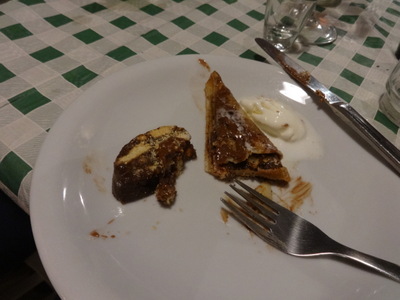
 As Françoise had predicted, the restaurant had no dessert menu, but with the check, the waiter brought us a plate with three little slices of sesame halvah and a nutella crepe with vanilla ice cream to share, together with three tiny glasses and a little glass carafe of raki, the ferocious local brandy made from the stuff left behind in the press when the grapes are crushed for wine.
As Françoise had predicted, the restaurant had no dessert menu, but with the check, the waiter brought us a plate with three little slices of sesame halvah and a nutella crepe with vanilla ice cream to share, together with three tiny glasses and a little glass carafe of raki, the ferocious local brandy made from the stuff left behind in the press when the grapes are crushed for wine.
When we arrived, very early by local standards, the place was mostly filled with tourists, but as we lingered over dinner, more and more locals showed up to replace them, and the heaping platters of seafood that kept arriving were a sight to see. A party of five seated next to us ordered, and got, a grilled sea bass large enough for everybody, which they proceeded to carve up and share, along with a huge bowl of fries.
Unfortunately, my shot of the lights on the shore across the bay came out all blurry, but it will at least show you the sort of scene we watched over dessert.

 On the way home, we walked by this beautiful church (left) and the archeological dig next to it (right). The lighting and its clean, smooth lines make it look like an architect's model, but that's really what the stone building looked like—it must be modern.
On the way home, we walked by this beautiful church (left) and the archeological dig next to it (right). The lighting and its clean, smooth lines make it look like an architect's model, but that's really what the stone building looked like—it must be modern.
We never did figure out what the big black plastic cylinder in the middle of the dig was for. A water supply for washing artefacts? A waste container? Who knows?
Back at the door of Françoise's hotel, we bid her a fond farewell, with many thanks for her roles as tour guide and translator. Monday morning, she took the early bus back to her little village (and e-mailed later to say she had arrived safely), so we won't see her again on this trip.